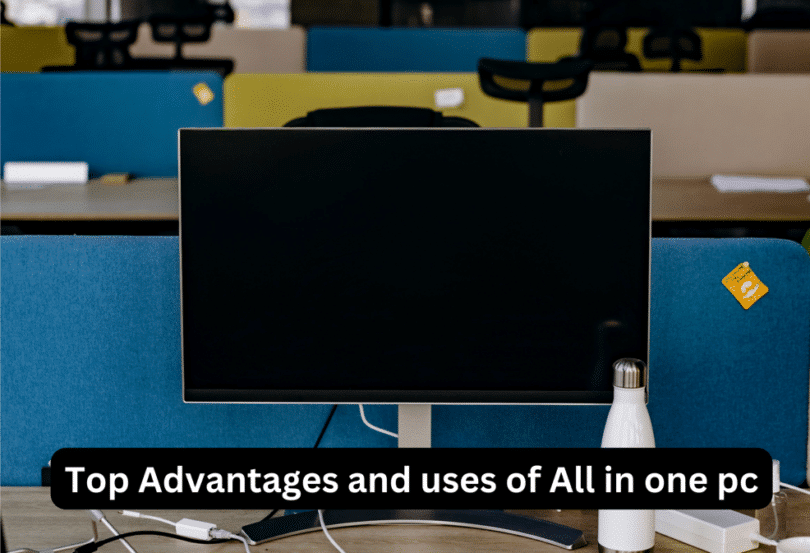Made in Pakistan
Top Advantages and uses of All in one pc

Because of their many benefits, All-in-one PCs have grown in popularity among computer users. One of the most significant advantages of All-in-one PCs is that they take up less space, making more room on your desk for other objects. All-in-one PCs are meant to save space and have a thinner form that takes up less total area than the bulkier tower and monitor setup.
This makes them an excellent choice for users who have limited space in their home or office. Another advantage of all-in-one PCs is that they have less cords than traditional desktop computers, making them more organized and easier to set up.
All-in-one PCs are further considered to be user-friendly and appealing to use, owing to their huge, touch-screen interfaces.
Because they are frequently purchased with capacity in mind, their design is sleek and visually pleasing in backgrounds and quality when compared to many traditional desktop computers. This makes them an appealing option for people who want a computer in a prominent location in their home or office. Furthermore, all-in-one PCs are typically portable and include optional battery (UPS) systems, making them an excellent choice for people who need to move their computer around regularly.
All-in-one PCs offer several benefits over traditional desktop computers, such as saving desk space, having fewer cables, being user-friendly, and having a sleek design. They are also renowned for typically offering as much or more performance than a laptop or other mobile computer.
However, they do have some limitations as well. Because they use components designed for mobile computers to keep their size small, all-in-one PCs tend to be more expensive and not always to the same level of performance as standard desktops. They can also be more difficult to upgrade than traditional desktops.
All-in-one PCs have become increasingly popular among computer users due to their many advantages. Here are some of the top advantages of all-in-one PCs:
Save space: All-in-one PCs have a slimmer design that takes up less space than traditional desktop computers, making them a great option for users who have limited space in their home or office.
Aesthetic design: All-in-one PCs have a sleek design that makes it attractive option for users who want a computer to place in a central spot in their home or office.
Portability: Some all-in-one PCs are portable and come with optional battery (UPS) systems, making them a good option for users who need to move their computer around frequently.
All-in-one: All-in-one PCs are a mix of a desktop and a monitor, often featuring a webcam and speakers. Because all those parts form one whole, they’re in tune. This also makes the setup a lot easier than when you choose a PC with a separate monitor.
All-in-one PCs have various advantages over traditional desktop computers, including the ability to save desk space, have less wires, be user-friendly, have a stylish look, and be an all-in-one solution for your computing needs. They do, however, have some limits. For example, they are typically more expensive than standard desktop computers, and they may not necessarily provide the same degree of performance.
What are the ideal uses for an all-in-one PC in a home or office setting?
All-in-one PCs are excellent family computers due to their all-encompassing design, which prevents a tangle of cords and other components. They are simple to assemble and operate, and they can conserve space in a shared family area.
All-in-one PCs might be an excellent alternative for a basic desktop for your new home office or classroom. They are meant to give a balance of practicality and form, and there are various types available on the market. They have a streamlined design that conserves space and maximizes every square inch.
All-in-one PCs include a webcam and speakers, making them ideal for video conferencing and other virtual meetings.
They are simple to set up and use, and they may assist you in staying in touch with coworkers, clients, and friends and family.
All-in-one PCs are meant to minimize space in already congested businesses or small living quarters. They are slimmer and take up less room than typical desktop computers.
In terms of upgradeability, how does an all-in-one PC differ from a standard desktop computer?
Traditional Desktop Computer All-In-One PC
| One of the biggest advantages of desktop PCs is that you can easily upgrade by replacing internal components
You are actually only restricted by the number of bays accessible in your PC case. Users often position it on top of or beneath their desks. Traditional desktop computers allow you to update practically every component, including the CPU, GPU, RAM, motherboard, fans/cooling, disc drive(s), and PS. |
All-in-one PCs have limited upgradability compared to traditional desktop computers.
The components in an all-in-one PC are densely packed, making access and upgrading difficult. Upgrades are typically limited to RAM or hard drive upgrades, and not all models permit even these upgrades. To minimize space, all-in-one PCs frequently use smaller versions of hardware components, including mobile processors. |
Traditional desktop computers have the advantage of being easily upgradable by replacing internal components, while all-in-one PCs have limited upgradability and often have lesser versions of hardware components. All in One pc has built-in components and preferred more with the advancement of technology.

